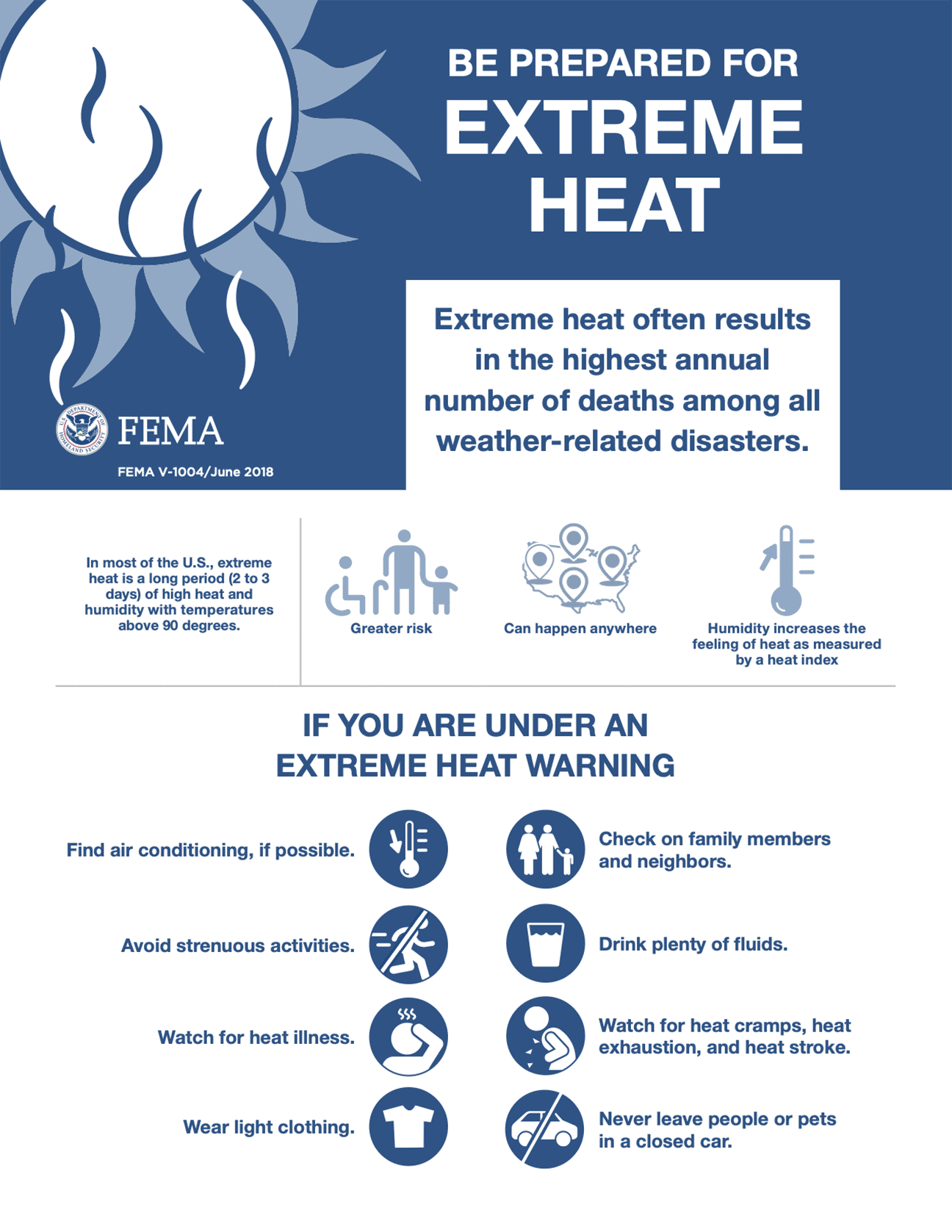
Beat the record breaking heat by practicing heat safety
Published July 7, 2022By Chris Jennings
The beginning of summer for many marks vacations, time off from school and a time to relax at the beach. With record-high heat across many parts of the country, it’s important to consider how to stay safe outdoors, especially during extreme heat conditions.
The Centers for Disease Control (CDC) defines extreme heat as summertime temperatures that are much hotter and/or humid than average. Because some places get warmer than others, this depends on what’s considered average for a particular location at that time of year. Humid and muggy conditions can make it seem hotter than it really is.
An Excessive Heat Warning is issued within 12 hours of the onset of extremely dangerous heat conditions. The general rule of thumb for this warning is when the maximum heat index temperature is expected to be 105° or higher for at least two days, and nighttime air temperatures will not drop below 75 degrees. However, these criteria vary across the country, especially for areas not used to extreme heat conditions. If you don’t take precautions immediately when conditions are extreme, you may become seriously ill or even die.
While everybody is affected by the heat, the young and elderly need to take extra precautions. “The young and the elderly are more susceptible [to extreme heat]. The young because they don’t have as much body surface to disseminate the heat. With the elderly, their body isn’t nearly as effective as a young, healthy person. The elderly also have a lot of other underlying medical issues that contribute to how the heat affects them,” said Gerrick Johnson with Choctaw Nation EMS.
The CDC says signs of overexposure to excessive heat conditions can begin with heat cramps. If you experience heavy sweating with muscle cramps during intense exercise, you should stop and move to a cool place, drink water or a sports drink and wait for the cramps to go away.
Signs of heat exhaustion are heavy sweating, cold, pale, clammy skin, fast, weak pulse, nausea or vomiting, muscle cramps, tiredness or weakness, dizziness, headache and fainting. If you or someone around you are experiencing these symptoms, you should move to a cool place, loosen your clothes and put a cool, wet cloth on the body.
“Number one is to get them out of the area and getting someplace cool. You can mist them or pour water on them and if you don’t see immediate improvement, make sure you call for help,” said Johnson.
Signs of heat stroke are body temperature that’s 103°F or higher, hot, red, dry, or damp skin, fast, strong pulse, headache, dizziness, nausea, confusion, and losing consciousness or passing out. If you see someone with these symptoms, you should call 911 immediately as heat stroke is a medical emergency. After that, move the person to a cooler place and help lower their temperature with a cool cloth.
“It’s just like it sounds…it’s a type of stroke, and it can be deadly like a stroke can be,” said Johnson.
Johnson says you can take steps to prevent getting into these situations. Pre-hydrating, timing your heat exposure for earlier or later in the day and wearing sunscreen with loose-fitting clothes covering more of your body can help with heat exposure.
Sunscreen is a simple first step to preventing problems related to heat. Sunburn affects your body’s ability to cool down and can make you dehydrated. You can protect yourself from the sun by wearing a wide-brimmed hat and sunglasses and by putting on sunscreen of SPF 15 or higher. “If you can wear a hat and sunscreen, it’s going to help you from burning,” said Johnson.
If you’re planning on attending the Labor Day celebration in September, Johnson says the Nation is taking steps to help with heat exposure. Water stations will be set up along with tents and canopies and a misting station for people to cool down.
Even when temperatures haven’t reached an excessive or extreme status, it’s important not to leave children or pets inside a car. Even if you leave a window open, cars can quickly heat up to dangerous temperatures. While anyone left in a parked car is at risk, children are especially at risk of getting heat stroke or dying. According to the Department of Meteorology & Climate Science at San Jose State University, 910 children have died in a car due to heat stroke since 1998.
Johnson says it’s important to think about heat safety. People who spend more time outside may be more accustomed to the heat, but those who don’t need to be careful and cool off before it becomes an issue. “They may push it over the edge, and once you go over the edge, that slope goes downhill pretty fast,” said Johnson.
